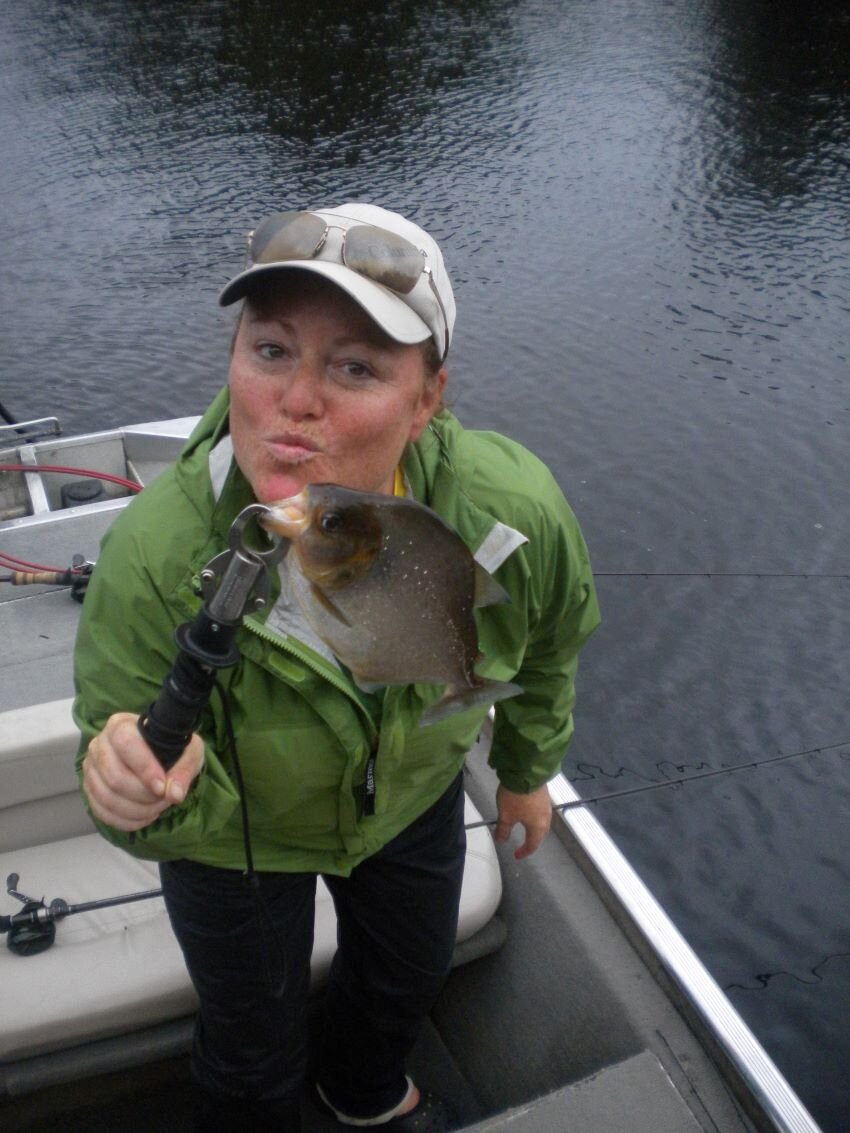Our Small Taste of the Amazon’s Variety
For most American anglers – and particularly for those of us who love to fish for largemouth bass – peacock bass are a logical stepping-off point into the Amazon. They’re certainly a worthy adversary, but the World Wildlife Fund estimates that there are more than 3,000 species of fish in the Amazon region, so if peacocks are the only thing you catch you are not even scratching the surface of the region’s potential. As demonstrated by the “Fishes of Amazonia” poster by Ray Troll, above, there are all sorts of exotic creatures to catch.
Hanna and I fished two tributaries of the Rio Negro (which meets with the Solimões in Manaus to form the Amazon) in the state of Amazonas in 2011 and 2012. Peacocks were our primary target, and we caught multiple different varieties of them, but along the way we lucked into a handful of other species as well. When I returned in 2019 to a river in the state of Mato Grosso, we knew that the river had smaller peacocks in it, but our primary target was monster wolf fish. Our group landed them up to nearly 30 pounds, and while I expected them to be “trash fish,” I was surprised that they turned out to be adversaries every bit the equal of the big peacocks. They attacked lures, including topwaters, put on aerial displays and made scorching, drag-searing runs.
On earlier trips, we had caught some of their smaller relatives. They particularly seemed to like a Saltwater Super Spook.
While I loved catching wolfies, for me the star of the show in 2019 was the sabertoothed payara (AKA, “Vampire Fish”). Even though our guides had a massive group of them pinned down, they confounded us, tortured us, and occasionally let one of us catch one to keep us coming back. We landed several in record-class proportions and I now have a replica in my office.
Not all of the vicious fish we’ve landed in Brazil have been large. On the tributaries of the Rio Negro you cannot help but catch a number of piranha every day out. If you throw your jigs into the fast water they’ll give them a “haircut.” The upside is that they are truly delicious.
On our trip to the Rio Caures in 2011, Hanna caught an arowana – a prehistoric air-breather also known as the “monkey fish” because they’ll jump out of the water to grab small animals and birds out of low-hanging branches.
Back in a lagoon where we caught some of our then-biggest peacocks, I landed a jacunda, another aggressive member of the cichlid family, albeit a comparatively small one.
On all three of our trips we’ve landed bicuda, sometimes referred to as the “freshwater barracuda,” another exceptional jumper with a row of fine teeth. This one ate a jerkbait in an eddy behind a rock outcropping.
On my 2019 trip to Mato Grosso, I also landed this fish on a jerkbait. I’m not sure if it is a sardinata or a matrinxã. Amazon experts, please advise!
Even though we don’t know many of the 3,000 or so other species, we’ve gotten to taste a few of them along the way. For example, while we have not caught pacu (also known as tambaqui), a fish which looks like an oversized non-carnivorous piranha, we have eaten their delicious ribs. Because the tambaqui eats fruits, the white meat is remarkably sweet. Our friend Steve Yatomi took us to a restaurant in Manaus that specializes in them in 2012.
Also, we never mustered the energy on our first two trips to go out catfishing at night, despite the fact that we went out caiman hunting. The river I visited in 2019 was reported not to be good for cats. Nevertheless, I’d really like to tussle with a big tiger-striped surubim.
I also think that the redtail cats are one of the most gorgeous “ugly species” in the world.
But the pinnacle for me would be to chase arapaima (AKA pirarucu) in Guyana. They are the largest scaled fish in the world, growing up to 500 pounds, they breathe air, and perhaps most importantly – they munch on swimbaits. Because these prehistoric beasts are so fragile, most of the operations that have arisen around them are very eco-conscious, but still I fear that we are racing against time to catch one in their natural habitat. That means Hanna and I NEED to go back to South America in the next few years.























